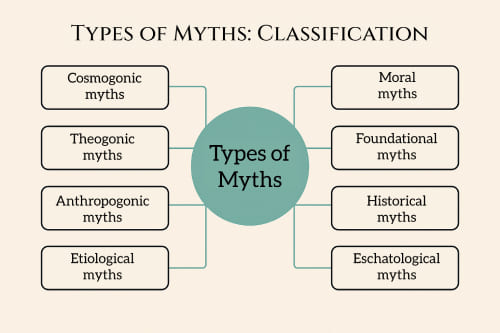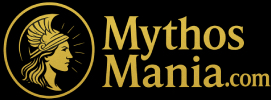Types of Myths: What they are, how they're classified, and famous examples
Since ancient times, myths have helped cultures make sense of the world around them. To better understand their function, myths are classified according to the theme they address: from the creation of the universe to the origin of human customs.
In this guide we show you the main types of myths with examples from different cultural traditions.
Recommended order of myth types
To better understand how myths are structured and what function each one serves, it's necessary to follow a logical order that goes from the origin of the universe to the final destiny of humanity. Below we show you a didactic sequence that will help you explore the different types of myths with greater clarity:
- Cosmogonic myths – origin of the universe
- Theogonic myths – origin of the gods
- Anthropogonic myths – creation of human beings
- Etiological myths – explanation of natural/cultural elements
- Moral myths – good, evil and consequences
- Foundation myths – founding of peoples and institutions
- Historical or national myths – collective identity
- Eschatological myths – end of the world and ultimate destiny
Types of myths
Myths can be classified into different categories according to the aspect of reality they seek to explain. This classification allows us to analyze the functions these stories served within their respective cultures, and how they relate to each other.

Below, we explore each of the main types of myths with their respective examples:
Cosmogonic myths
They explain the origin of the world and the universe.
This type of myth answers the great questions about how everything that exists came to be: the sky, the earth, the sea, the stars and time. They are usually led by primordial gods, chaotic forces or creative entities that shape the universe from nothing or from disordered matter.
- Greek example: The primordial Chaos and the birth of Gaea and Uranus.
- Mayan example: The creation of heaven and earth in the Popol Vuh.
Theogonic myths
They narrate the origin of the gods and their genealogy.
These myths tell how divinities arose, their kinship relationships and the hierarchies that exist among them. They are fundamental for understanding the religious worldviews of many cultures, as they explain the role of gods in creation and the order of the world.
- Greek example: Theogony by Hesiod.
- Egyptian example: The birth of Osiris, Isis and Horus.
Anthropogonic myths
They narrate the creation of human beings.
They focus on explaining how, why and from what human beings were created. These stories usually link human beings to sacred or natural elements, and often include failed attempts at creation before achieving the definitive form of humanity.
- Mayan example: Men of corn in the Popol Vuh.
- Sumerian example: Enki and Ninmah creating humanity.
Etiological myths
They explain the origin of natural elements, institutions or customs.
These myths offer a symbolic explanation of why certain concrete realities exist: animals, natural phenomena, rites, laws or cultural practices. They function as narratives that justify and grant legitimacy to what is known within a society.
- Greek example: Arachne transformed into a spider by Athena.
- Norse example: The rainbow as the Bifröst bridge.
Moral myths
They address the existence of good and evil, and the consequences of human actions.
These stories have an exemplifying function: they show what happens when divine or social norms are violated. They often explain the origin of suffering, death or punishment, while transmitting fundamental values for the community.
- Greek example: Pandora and the box of evils.
- Biblical example: Adam and Eve in the Garden of Eden.
Foundation myths
They tell the founding of cities, nations or institutions.
Their objective is to give mythical legitimacy to the origin of a political or cultural community. They normally involve the intervention of heroes, gods or ancestral figures, and contribute to strengthening the sense of belonging and unity of a people.
- Roman example: Romulus and Remus founding Rome.
- Inca example: Manco Cápac and Mama Ocllo at Lake Titicaca.
Historical or national myths
They narrate legendary events that consolidate the identity of a people.
Although they are often based on real facts or historical characters, these myths transform them into symbolic narratives that reinforce collective identity. They are usually used to exalt the glorious past of a culture and justify its present or destiny.
- Mexica example: The myth of Aztlán, origin of the Aztecs.
- Japanese example: The divine lineage of the emperor.
Eschatological myths
They describe the end of the world or the final destiny of humanity.
They focus on the outcome of time, the destruction of the known world or the transformation of reality. These myths are usually loaded with symbolism and drama, and often involve divine judgments, catastrophes and cyclical rebirths.
- Norse example: Ragnarök.
- Christian example: The Apocalypse according to Saint John.
Comparative table of myth types
| Type of myth | What it explains | Example |
|---|---|---|
| Cosmogonic | The origin of the universe | Primordial Chaos (Greek mythology) |
| Theogonic | The origin of the gods | Theogony by Hesiod (Greek mythology) |
| Anthropogonic | The creation of human beings | Men of corn (Mayan mythology) |
| Etiological | Natural elements or customs | Arachne and spiders (Greek mythology) |
| Moral | Good, evil and consequences | Pandora and the jar - Pandora's box (Greek mythology) |
| Foundation | The founding of cities or institutions | Romulus and Remus (Roman mythology) |
| Historical or nationalist | Identity of a people or nation | Aztlán (Mexica mythology) |
| Eschatological | The end of the world | Ragnarök (Norse mythology) |
Frequently asked questions about types of myths
Can the same myth belong to several types?
Yes, some myths combine elements from different categories. For example, a myth can be cosmogonic and theogonic at the same time.
What are the oldest known myths?
Among the oldest are Sumerian, Egyptian and Mesopotamian myths, many of which are preserved on clay tablets.
Are myths still being created today?
Yes, although they adopt new forms. Many modern pop culture narratives have mythic structure.
Myths, in addition to explaining the inexplicable, reflect the culture and spirituality of peoples. Knowing their types allows you to better understand how human beliefs have evolved.
Do you want to know famous and easy-to-read examples?
Explore our selection of short myths →
